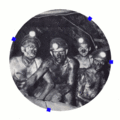User:Manetta/i-could-have-written-that/from-mining-minerals-to-mining-data: Difference between revisions
No edit summary |
|||
| Line 1: | Line 1: | ||
<div style="width:100%;max-width:800px;"> | <div style="width:100%;max-width:800px;"> | ||
__TOC__ | |||
=''mining''= | =''mining''= | ||
what does it mean? | what does it mean? | ||
what is meant with it? | what is meant with it? | ||
=='mining' differences== | =='mining' differences== | ||
| Line 19: | Line 20: | ||
| to mine = to extract || to mine = to derive | | to mine = to extract || to mine = to derive | ||
|} | |} | ||
==from: mining minerals== | ==from: mining minerals== | ||
| Line 38: | Line 40: | ||
analogy to regulations of the amount of oxygen | analogy to regulations of the amount of oxygen | ||
==via: archeology== | |||
''Archeology is the study of human activity through the recovery and analysis of material culture.'' [https://en.wikipedia.org/wiki/Archaeology (from: Wikipedia, Archeology - 11th Jan. 2016)] | |||
==to: mining data== | ==to: mining data== | ||
| Line 61: | Line 68: | ||
* Stanford research paper presenting Google, ''The Anatomy of a Large-Scale Hypertextual Web Search Engine'', by Sergey Brin + Lawrence Page [http://infolab.stanford.edu/~backrub/google.html (paper html, 1998)], [http://infolab.stanford.edu/pub/papers/google.pdf (paper pdf, 1998)] | * Stanford research paper presenting Google, ''The Anatomy of a Large-Scale Hypertextual Web Search Engine'', by Sergey Brin + Lawrence Page [http://infolab.stanford.edu/~backrub/google.html (paper html, 1998)], [http://infolab.stanford.edu/pub/papers/google.pdf (paper pdf, 1998)] | ||
* research paper by Sergey Brin on Nearest Neighbours; [http://infolab.stanford.edu/~sergey/near.html (paper, 2005)] | * research paper by Sergey Brin on Nearest Neighbours; [http://infolab.stanford.edu/~sergey/near.html (paper, 2005)] | ||
==notes== | ==notes== | ||
Revision as of 17:43, 11 January 2016
mining
what does it mean?
what is meant with it?
'mining' differences
| mining minerals | mining data |
|---|---|
| natural resource | not natural resource |
| non-renewable | constantly renewed |
| mineral = product | data = cultural by-product |
| to mine = to extract | to mine = to derive |
from: mining minerals
Mining is required to obtain any material that cannot be grown through agricultural processes, or created artificially in a laboratory or factory. Mining in a wider sense includes extraction of any non-renewable resource such as petroleum, natural gas, or even water.
Mining operations usually create a negative environmental impact, both during the mining activity and after the mine has closed.
Mineral processing (or mineral dressing) is a specialized area in the science of metallurgy that studies the mechanical means of crushing, grinding, and washing that enable the separation (extractive metallurgy) of valuable metals or minerals from their gangue (waste material).
from: Wikipedia (5th Jan. 2016)
Products that make modern life work. (...) Our major products are aluminium, copper, diamonds, gold, industrial minerals (borates, titanium dioxide and salt), iron ore, thermal and metallurgical coal and uranium.
notes
creating value out of material that used to belong to nobody
analogy to regulations of the amount of oxygen
via: archeology
Archeology is the study of human activity through the recovery and analysis of material culture. (from: Wikipedia, Archeology - 11th Jan. 2016)
to: mining data
computer science
data science
data as resource
- Google books as fuel for information control (and data-extraction? → speculation...), tightening corporate control over information; Appellate Court Ruling For Google Books: Fair Use, or Anti-Democratic Preemption?;
history of 'data mining' as term
appearances:
60s
90s - 20??
- Yahoo Groups mailinglist for the Stanford Data Mining group, first message from 30th Oct. 1997; Sergey Brin + Jeff Ullman + Howard Ho + George H. John + Pat Langley; (list of first messages, 1997), (group overview, 2002), (group overview, 2008)
- journal started in 1997, Data Mining and Knowledge Discovery; (overview of issues, 1997 - now)
- MIT thesis; ParaSite: Mining Structural Information on the Web, by Ellen Spertus; (paper, Feb. 1997/8) [also the name of] The Sixth International WWW Conference (WWW 97). Santa Clara, USA, April 7-11, 1997. (reference from Brin + Page, 1998) Also appearing in Computer Networks and ISDN Systems: The International Journal of Computer and Telecommunications Networking 29 (1997) 1205-1215.
- Stanford research paper presenting Google, The Anatomy of a Large-Scale Hypertextual Web Search Engine, by Sergey Brin + Lawrence Page (paper html, 1998), (paper pdf, 1998)
- research paper by Sergey Brin on Nearest Neighbours; (paper, 2005)
notes
no ne

